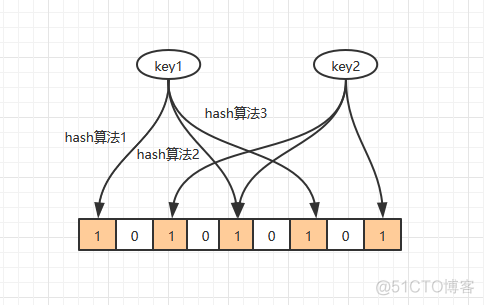
介绍
我们以演进的方式来逐渐认识布隆过滤器。先抛出一个问题爬虫系统中URL是怎么判重的?你可能最先想到的是将URL放到一个set中,但是当数据很多的时候,放在set中是不现实的。
这时你就可能想到用数组+hash函数来实现了。
index = hash(URL) % table.length即求出URL的hash值对数组长度取模,得到数组的下标,然后设置table[index] = 1,当然数组刚开始的元素都为0
这样每次有新的URL来的时候,先求出index,然后看table[index]的值,当为0的时候,URL肯定不存在,当为1的时候URL可能存在,因为有可能发生hash冲突。即第一次
hash(www.baidu.com) % table.length = 1,table[1]=1,第二次hash(www.javashitang.com) % table.length = 1,此时table[1]=1,系统会认为www.javashitang.com已经爬取过了,其实并没有爬取。
从上面的流程中我们基本可以得出如下结论:hash冲突越少,误判率越低
怎么减少hash冲突呢?

多个hash函数求得数组位置的值都为1时才认为这个元素存在,只要有一个为0则认为这个元素不存在。在一定概率上能降低冲突的概率。
那么hash函数是不是越多越好呢?当然不是了,hash函数越多,数组中1的数量相应的也会增多,反而会增加冲突。所以hash函数不能太多也不能太少。
你可能没意识到布隆过滤器的原理你已经懂了,只不过布隆过滤器存0和1不是用数组,而是用位,我们来算一下申请一个 100w 个元素的位数组只占用 1000000Bit / 8 = 125000 Byte = 125000/1024 kb ≈ 122kb 的空间,是不是很划算?
来总结一下布隆过滤器的特点
使用场景
手写一个布隆过滤器
public class MyBloomFilter {// 位数组的大小
private static final int DEFAULT_SIZE = 2 << 24;
// hash函数的种子
private static final int[] SEEDS = new int[]{3, 13, 46};
// 位数组,数组中的元素只能是 0 或者 1
private BitSet bits = new BitSet(DEFAULT_SIZE);
// hash函数
private SimpleHash[] func = new SimpleHash[SEEDS.length];
public MyBloomFilter() {
for (int i = 0; i < SEEDS.length; i++) {
func[i] = new SimpleHash(DEFAULT_SIZE, SEEDS[i]);
}
}
// 添加元素到位数组
public void add(Object value) {
for (SimpleHash f : func) {
bits.set(f.hash(value), true);
}
}
// 判断指定元素是否存在于位数组
public boolean contains(Object value) {
boolean ret = true;
for (SimpleHash f : func) {
ret = ret && bits.get(f.hash(value));
// hash函数有一个计算出为false,则直接返回
if (!ret) {
return ret;
}
}
return ret;
}
// hash函数类
public static class SimpleHash {
private int cap;
private int seed;
public SimpleHash(int cap, int seed) {
this.cap = cap;
this.seed = seed;
}
public int hash(Object value) {
int h;
return (value == null) ? 0 : Math.abs(seed * (cap - 1) & ((h = value.hashCode()) ^ (h >>> 16)));
}
}
public static void main(String[] args) {
Integer value1 = 13423;
Integer value2 = 22131;
MyBloomFilter filter = new MyBloomFilter();
// false
System.out.println(filter.contains(value1));
// false
System.out.println(filter.contains(value2));
filter.add(value1);
filter.add(value2);
// true
System.out.println(filter.contains(value1));
// true
System.out.println(filter.contains(value2));
}
}
利用Google的Guava工具库实现布隆过滤器
生产环境中一般不用自己手写的布隆过滤器,用Google大牛写好的工具类即可。
加入如下依赖
<dependency><groupId>com.google.guava</groupId>
<artifactId>guava</artifactId>
<version>27.0.1-jre</version>
</dependency>// 创建布隆过滤器对象,最多元素数量为500,期望误报概率为0.01
BloomFilter<Integer> filter = BloomFilter.create(
Funnels.integerFunnel(), 500, 0.01);
// 判断指定元素是否存在
// false
System.out.println(filter.mightContain(1));
// false
System.out.println(filter.mightContain(2));
// 将元素添加进布隆过滤器
filter.put(1);
filter.put(2);
// true
System.out.println(filter.mightContain(1));
// true
System.out.println(filter.mightContain(2));
用Redis中的布隆过滤器
Redis4.0以插件的形式提供了布隆过滤器。来演示一波
使用docker安装并启动
docker pull redislabs/rebloomdocker run -itd --name redis -p:6379:6379 redislabs/rebloom
docker exec -it redis /bin/bash
redis-cli
常用的命令如下
# 添加元素bf.add
# 查看元素是否存在
bf.exists
# 批量添加元素
bf.madd
# 批量查询元素127.0.0.1:6379> bf.add test 1
(integer) 1
127.0.0.1:6379> bf.add test 2
(integer) 1
127.0.0.1:6379> bf.exists test 1
(integer) 1
127.0.0.1:6379> bf.exists test 3
(integer) 0
127.0.0.1:6379> bf.exists test 4
(integer)
欢迎关注

参考博客
GitHub JavaGuide
《Redis深度历险》
[1]https://github.com/Snailclimb/JavaGuide/blob/master/docs/dataStructures-algorithms/data-structure/bloom-filter.md
